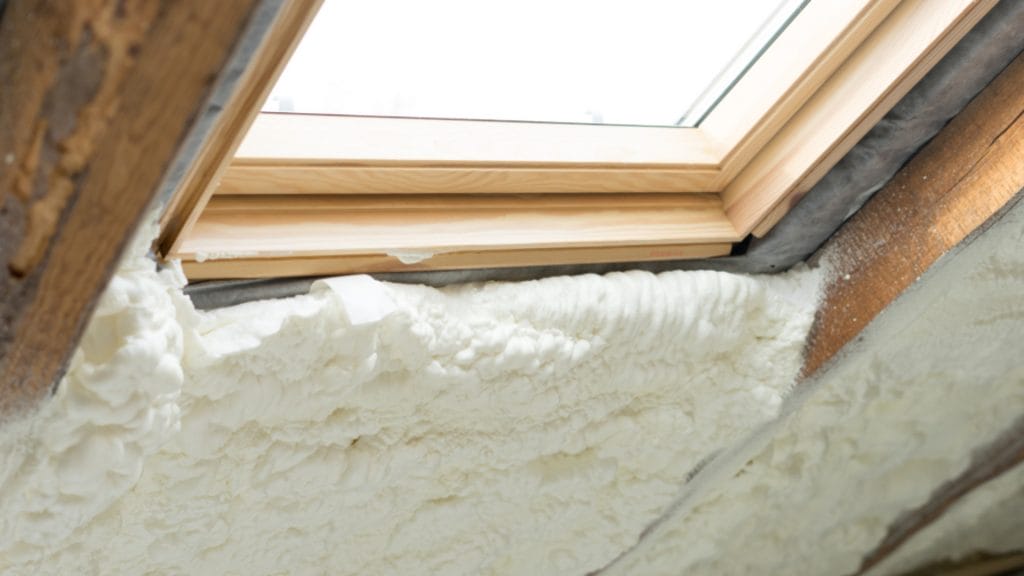When building a home, one of the critical ingredients of a comfortable home is the insulation. Inserted between the studs in the walls, in the ceiling, and even under the flooring, insulation arrests air infiltration and decreases heat gain or loss. The better the insulation, the more comfortable the home and the less expensive the utility bills. By preventing warmth from dissipating through the ceiling and walls in winter, the less the heater needs to be run, and the same with cool air in summer. With the cold winters of Maryland and Washington D.C., good insulation is really important.
While industry standards have changed over the decades, there are ever more types of insulation on the market. Options vary in price and efficacy, and different builders prefer different ones. At Winthorpe, we’ve used several kinds of insulation over the years. Some home designs require one type of insulation, while a homeowner may specifically request the use of another. We’re flexible. But do we have a preference? In general, yes.
Spray foam insulation, in our opinion and experience, produces the best results at the most reasonable cost. There are many factors to consider for any insulation, and there may be times when spray foam isn’t ideal, and we’ll discuss that in a moment. But generally, spray foam insulation is our preference. It’s a polyurethane that is literally sprayed into all the gaps in the walls and ceiling, creating a very tight thermal insulation with little to no opportunity for air infiltration (the passing of air from indoors to out or vice versa, allowing for undesirable heat exchange).
 The biggest competitor to spray foam is what’s called “batt” insulation. Batt is usually made of fiberglass or rock wool, pre cut into long narrow strips, and stuffed in between the studs. In terms of cost, batt comes in a variety of R values (the rating which indicates how insulating it is). The higher the R value, the more expensive the batt. It works very well, but it does leave some room for air infiltration at the edges. Also, over time, gravity causes batt to sag within the walls, leaving air gaps at the top. In this age of green homes, where we’re striving for air-tightness and absolute energy efficiency, batt, which can’t fill every tiny space, may not be as effective as spray foam.
The biggest competitor to spray foam is what’s called “batt” insulation. Batt is usually made of fiberglass or rock wool, pre cut into long narrow strips, and stuffed in between the studs. In terms of cost, batt comes in a variety of R values (the rating which indicates how insulating it is). The higher the R value, the more expensive the batt. It works very well, but it does leave some room for air infiltration at the edges. Also, over time, gravity causes batt to sag within the walls, leaving air gaps at the top. In this age of green homes, where we’re striving for air-tightness and absolute energy efficiency, batt, which can’t fill every tiny space, may not be as effective as spray foam.
Spray foam is more expensive than batt. In the long run, it pays for itself in reduced utility bills over the lifetime of the home. However, to save money on the construction of a home, one option is to use both kinds of insulation, installed in different places to play to their strengths. We’ll use spray foam in the ceiling, around the ventilation ducts, and in some walls, as those are the places where heat loss is greatest. Then we’ll use batt in the remaining walls, and that will produce a very tight home. If the budget allows, we’ll also spray foam under the floors, which adds extra insulation and also attenuates sound. Clients for whom we’ve insulated an entire house in spray foam have told us they’re amazed at how well it maintains the temperature in the home and how infrequently they need to use their HVAC system.
When is spray foam not ideal? While spray foam does not emit VOCs (volatile organic compounds are slow-emitting gases that can have adverse health effects), it does emit some fumes when it’s first sprayed. This is natural for a liquid-type solution that must dry into a solid. Once upon a time, a home had to be vacated for a full 24 hours after spraying foam insulation. But ingredients and formulas have come a long way and nowadays the fumes are less intense and dissipate in a very short period of time, so there’s no health risk. But residents with serious health issues or acute, life-threatening allergies may elect not to use spray foam on principle, even though the fumes dissipate within hours and there are no VOCs. We respect that and, in those cases, batt will work.





